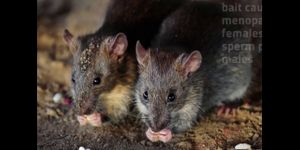Progress in the Fight Against a Deadly Parasitic Disease
New work reported in Nature Communications by an international team of researchers is a big step forward in the fight against schistosomiasis, a deadly parasitic disease that kills hundreds of thousands of people annually around the world. An international team of researchers, led by University of New Mexico Associate Professor Coenraad Adema, took an in-depth look at the genome of a snail that plays an important part in the cycle of the disease (described in the following video).
The research article, 'Whole genome analysis of a schistosomiasis-transmitting freshwater snail', published in Nature Communications this week, gives the scientific community an in-depth look of the sequenced genome of Biomphalaria glabrata, a tropical Ram's Horn snail.
"Sequencing and characterizing the genome of this snail has given us a lot of information into its biology," said Adema, who is also part of UNM's Center for Evolutionary and Theoretical Immunology (CETI) that has played a pivotal role in this project. "It has informed us on animal evolution and supports the drive to minimize the impact of infectious disease on global health."
Biomphalaria glabrata is a tropical Ram’s Horn snail that lives only in tropical climates and plays a significant role in the lifecycle of the parasitic disease schistosomiasis, also known as snail fever or bilharzia. The snail is infected by the parasite early on its life. The virus hijacks the reproductive and metabolic functions of the snail, and after it has developed, the parasite exits the snail and can then infect a human host through contact in water.
Adema suggested that a better understanding of how the interaction between snail and parasite works, it can be stopped, potentially cutting the snail out of the lifecycle of the parasite. The snail plays an essential role the organism's development and without it, the parasite is not able to mature, or go on to infect humans. Knowing a lot about the genetics of an organism can help researchers investigate that relationship and cycle.
"Understanding the snail's genome gives us many avenues to cut the snail out of this parasite's lifecycle, which one day may lead to the elimination of this disease" explained Adema.
Schistosomiasis is a major health problem for some parts of the world (learn more in the video above); the World Health Organization (WHO) estimates that more than 66 million people were treated for the disease in 2015, and another 218 million people needed preventative treatment. Additionally, snail fever kills around a quarter of a million people every year in sub-Saharan Africa alone.
One reason why it afflicts so many people is because it’s incredibly easy to transmit; the parasite can simply survive in water until it enters a break in human skin. Simply by putting your hand in the Nile River, for example, can cause infection. The WHO has a goal of eliminating snail fever by 2025, and this work may help meet that challenge.
"After malaria, this is the worst parasitic disease on the planet," said Adema. "So, being able to do work that may help improve global human health outcomes it is a very important motivation for my research."
More than 100 researchers from 50 institutions around the world are a part of this study and latest publication - a testament to how significant and wide-reaching this disease and its overall impact is.
Adema commented that several of his colleagues are now trying different, novel ways to use the genome of the snail to fight the disease. Although the parasite and illnesses are the focus of this work, there is more to gained from examining the genome.
"This is an important contribution to better understanding infectious disease," he continued. "It also gives us information on regulation of gene expression, comparative immunology, embryology, general biology of snails, animal evolution and many other things."
Sources: AAAS/Eurkealert! Via University of New Mexico, WHO Nature Communications








